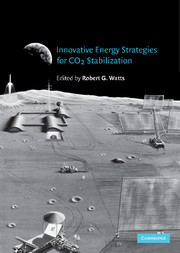Book contents
- Frontmatter
- Contents
- List of contributors
- 1 Concerns about Climate Change and Global Warming
- 2 Posing the Problem
- 3 Adaptive Strategies for Climate Change
- 4 Energy Efficiency: a Little Goes a Long Way
- 5 The Potential of Renewable Energy to Reduce Carbon Emissions
- 6 Carbonless Transportation and Energy Storage in Future Energy Systems
- 7 What Can Nuclear Power Accomplish to Reduce CO2 Emissions
- 8 Nuclear Fusion Energy
- 9 Energy Prosperity Within the Twenty-first Century and Beyond: Options and the Unique Roles of the Sun and the Moon
- 10 Geoengineering the Climate: History and Prospect
- Index
7 - What Can Nuclear Power Accomplish to Reduce CO2 Emissions
Published online by Cambridge University Press: 22 October 2009
- Frontmatter
- Contents
- List of contributors
- 1 Concerns about Climate Change and Global Warming
- 2 Posing the Problem
- 3 Adaptive Strategies for Climate Change
- 4 Energy Efficiency: a Little Goes a Long Way
- 5 The Potential of Renewable Energy to Reduce Carbon Emissions
- 6 Carbonless Transportation and Energy Storage in Future Energy Systems
- 7 What Can Nuclear Power Accomplish to Reduce CO2 Emissions
- 8 Nuclear Fusion Energy
- 9 Energy Prosperity Within the Twenty-first Century and Beyond: Options and the Unique Roles of the Sun and the Moon
- 10 Geoengineering the Climate: History and Prospect
- Index
Summary
Overview
General considerations
In the US we now emit 11% more CO2 than in 1990; and at Kyoto we promised to reduce CO2 emissions to 8% below 1990 levels in ten years for a decrease of 19% below today's levels. If all the electricity now generated by nuclear power were to be generated by coal, CO2 emissions would increase by another 8%, making it more difficult to meet our commitment if we abandon nuclear power. About 30 years ago Dr. Glenn Seaborg, then Chairman of the US Atomic Energy Commission (AEC), testified to the Joint Committee of Atomic Energy of the US Congress (JCAE) that nuclear power would be comparatively benign environmentally (in particular, not producing appreciable CO2) and also would produce electricity at a modest cost (Seaborg, 1968). This optimism was nationwide and worldwide. Since that time opposition to nuclear power has arisen, and nuclear power at the present moment is not being considered by most governments in the world as an option to meet energy and environmental aims and desires. Our purpose is to show ways in which nuclear power could help the world, and in particular the US, to meet commitments made at Kyoto. Our purpose is also to examine the causes of the changes in the fortunes of nuclear energy and to discuss the extent to which nuclear power can provide electricity worldwide safely and economically.
- Type
- Chapter
- Information
- Innovative Energy Strategies for CO2 Stabilization , pp. 211 - 324Publisher: Cambridge University PressPrint publication year: 2002



